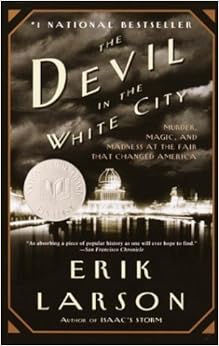About two decades ago, I was watching Jeopardy with a friend. There was a category on one particular segment: recent best-sellers. Both of us worked at a bookstore at the time, and we named each book off correctly and quickly. Those days are gone. I no longer work in a bookstore, and I don't pay that much heed to what's on the best-seller list and have a hard time even keeping track off what's new and notable. Nevertheless, I think Larson's book was a best-seller sometime last year. And I understand why. Having heard the premise, I was naturally attracted to it.
It's the story of the 1893 Chicago World's Fair, the Columbian Exposition, completed for the four-hundredth anniversary of Columbus's voyage to America. The fair is the origin of Columbus Day in the United States, a holiday I remember getting out of school for when I was a grade school student (I don't recall ever getting it off for work or for school once I was older). It's also the origin of the Ferris wheel--the first one was built by William Ferris for this exposition, a huge one, that carried hundreds of people in each car. It was built as the exposition's centerpiece, just as the Eiffel Tower had been built as the Paris World's Fair centerpiece only a few years before.
Reading about how this exposition came about, about the marvelous architecture that was put up in less than a couple of years, I was entranced. The story reminded me, in fact, of my own job, editing books. There, those of us who work in production, I often asked to do similar miracles, to put out books within what seem to be impossible time frames. Often, we do. And often, those time frames are made more difficult by our own coworkers, as was the case with the fair, where the first six months of construction and planning was wasted arguing over where to even put the fair within Chicago. That so much could be built within so little time, that so many bad odds could be overcome, seems amazing--and makes putting out a book actually quite easy. (Cost is always one other issue, and on that, the planners did have an advantage in that virtually no dollar was spared. The fair only made back what it cost to build in the last twenty days of its existence.)
The other story that Larson tells is that of a serial killer who used the fair to prey on mostly innocent people. He builds a hotel that becomes a death trap--rooms with gas pumps in them, with doors that lock soley from the outside. And he builds it largely with borrowed money. He kills his victims for his own pleasure, listening to them suffer, and then he makes money on them--selling their bodies for medicine, collecting life insurance, and so on. This story, I found, surprisingly less compelling than that of the fair. Certainly, such an audacious character is interesting at some level, but fairly early in the book, I became so disgusted by him that I wasn't sure I wanted to know any more. I found myself dreading each next passage about him. At least ten people died by his hand, though some people estimate as high as a couple of hundred (the true number is unknown but likely somewhere in the twenties or thirties).
That Larson incorporates the latter story with the fair, however, as well as with stories of the Chicago mayor's assassination and with the country's economic woes (I couldn't help but identify the Panic of 1893 with our own current fiscal problems), makes the story of Chicago's fair all the more interesting, however. It becomes a story not only of putting on a fair but of life near the turn of the century and of the city of Chicago.
Saturday, January 10, 2009
On "The Devil in the White City" by Erik Larson *****
Labels:
Books,
Erik Larson,
Five-Star Nonfiction,
Nonfiction
Subscribe to:
Post Comments (Atom)







No comments:
Post a Comment